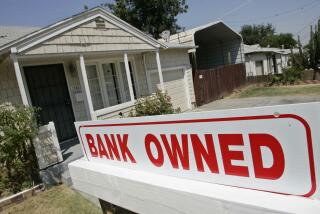Quake Victims Face Backlog of House Payments : Mortgages: Lenders say some customers deserve more time. Others may be allowed to tack the new debt onto their loans.
Thousands of Southern California property owners whose homes were damaged by January’s earthquake are bracing for a strong financial aftershock, now that the moratorium on their mortgage payments is nearing an end.
Bank of America, Great Western Bank and other major lenders have begun sending out letters to more than 10,000 borrowers who were granted 90-day suspensions of their house payments while they regrouped from effects of the Jan. 17 temblor.
“A lot of people took us up on our (offer of a) 90-day payment moratorium, and we have the right to collect all of those payments when the 90 days are up,” said Dale Ruby, BofA’s senior vice president.
Homeowners who had already made their January payments when the earthquake struck have a little more breathing room, Ruby said, because they won’t be expected to come up with four payments until May.
Most borrowers whose homes were destroyed or who face lengthy repair periods have already received long-term relief packages from their lenders.
But bankers say that most customers simply received a 90-day payment moratorium so they could use their cash to meet short-term expenses while awaiting aid from federal agencies, such as the Federal Emergency Management Agency or Small Business Administration.
With the moratorium almost over, borrowers now must make up for the payments they have skipped. “I haven’t gotten a letter yet, but I’m just dreading what it’s going to say,” said Mary Ann Davis, a retiree who has skipped about $3,600 in payments since the quake caused minor damage to a rental house she owns in Granada Hills.
Davis said the temblor was enough to send her tenants packing to Arizona, and that cost her more than $1,000 in lost rent. Although she has found new tenants, they paid only $2,200 to move in--half of which was gobbled up as commission for the leasing agent--and she does not have the cash to make the back house payments.
Lenders promised that they will try to make alternative payment arrangements for borrowers who still are not back on their feet, but cautioned that additional financial assistance will be more difficult to obtain a second time.
“The first time around, we gave forbearance to just about anybody who asked for it,” said Steve Hawkins of Chatsworth-based Great Western, which granted payment relief to about 2,500 of its borrowers after the quake.
“Now, if you call up and ask for more help, we’re going to inspect your property and make our decisions on a case-by-case basis,” Hawkins said. “We’ll help you if you really need it, but we’re going to have to corroborate your story first.”
Although many homeowners will be ineligible for further help, they will not necessarily have to write one large check for all the payments they have missed.
Lenders say that some customers will be allowed to add $100 or $200 to each future payment to bring their accounts slowly back up to date, while others will be able to add their missed payments to their outstanding balances and pay back the money later, when the home is sold or refinanced.
Privately, most bankers admit that they don’t look forward to the difficult decisions as to who will get further mortgage relief and who will not.
“We’re going to be sending out more than 2,000 letters to borrowers asking them to pony up their back payments, which means we’ll probably get about 2,000 phone calls from people who will be screaming bloody murder,” an official at one large bank said.
Stewart Cramer, an aerospace worker, said his bank granted him a 90-day payment moratorium shortly after the earthquake, which caused an estimated $25,000 in damage to his Northridge home.
But Cramer has yet to make any repairs, because his lender has not decided whether he will have to come up with $5,000 in a lump sum to make up for the skipped payments when the moratorium ends next month.
“I just don’t have $5,000 lying around, and I won’t be able to pay the bank if they ask for it,” Cramer said. He added that his house was worth $35,000 less than he paid for it, even before the quake.
“There’s no reason for me to go out and borrow $25,000 to fix the place up if I’m going to be in foreclosure in May. I’d just be throwing good money after bad.”
Ironically, borrowers such as Cramer--who have no equity left in their homes and therefore little incentive to spend heavily on repairs--may have a slight edge in negotiating with lenders for additional help.
“Banks tend to be more lenient with borrowers who don’t have any equity, because they’re the people who have nothing to lose in a foreclosure,” said Alan Kheel, a Sherman Oaks real estate attorney.
At the same time, Kheel said, “some lenders are playing hard-ball with longtime borrowers” who have lots of equity, because those homeowners could lose thousands of dollars of their own investment if they default on their loans.
More to Read
Sign up for Essential California
The most important California stories and recommendations in your inbox every morning.
You may occasionally receive promotional content from the Los Angeles Times.









